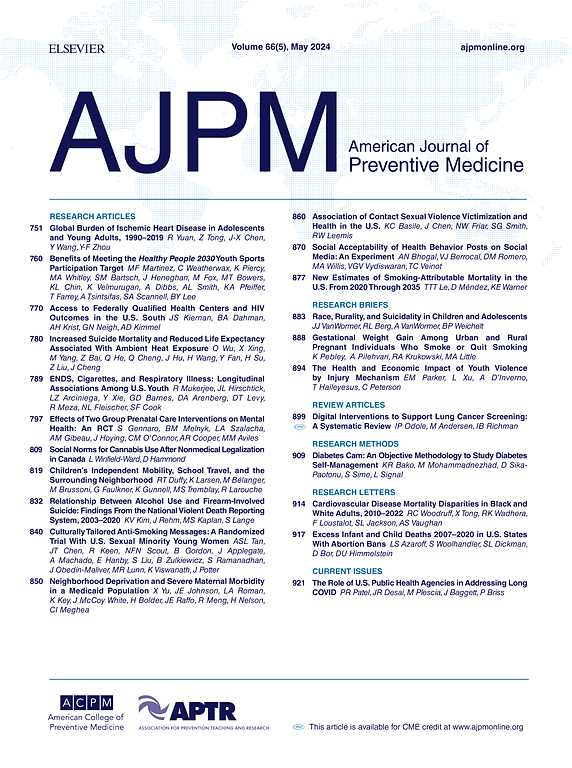Crisis Circumstances in Adult U.S. Suicide Deaths: A Latent Class Analysis
IF 4.5
2区 医学
Q1 MEDICINE, GENERAL & INTERNAL
引用次数: 0
Abstract
Introduction
Suicide is a critical public health issue in the U.S., where it ranks as the 11th leading cause of death. Precipitating crises are life events that occur prior to a suicide and increase risk. This study aimed to identify distinct groupings of precipitating crises in adults who died by suicide.
Methods
Data from the National Violent Death Reporting System included 55,448 suicides from 2013 to 2021, where the decedent had experienced a precipitating crisis in the 2 weeks surrounding death. Crisis variables were used to model latent classes of circumstances through Latent Class Analysis. Models were fit with 2–10 classes, and the optimal solution was selected through fit statistics, entropy, and interpretability. Logistic regression was used to assess the associations between demographic characteristics (age, sex (male/female), race, ethnicity, military status, rurality) and class membership. All analyses were performed in 2024.
Results
A 6-class model best fit the data, including (1) co-occurring substance use, alcohol, relationship, and eviction; (2) physical health; (3) other; (4) criminal legal; (5) co-occurring job, financial, and intimate partner; and (6) intimate partner crises. There was significant variation in class membership by demographic characteristics. For example, adults aged 55–65 years had higher odds of belonging to Class 2 than younger adults (AOR=18.53; 95% CI=13.12, 26.93).
Conclusions
This study identified 6-crisis profiles with patterns of life events that can be recognized by healthcare providers. Individuals experiencing single-circumstance crises may benefit from addressing the specific stressor, whereas those in multifaceted-crisis profiles likely require comprehensive interventions that tackle overlapping stressors simultaneously.
美国成人自杀死亡的危机环境:潜在阶层分析。
在美国,自杀是一个重要的公共卫生问题,在死亡原因中排名第11位。突发危机是发生在自杀之前的生活事件,会增加自杀的风险。这项研究的目的是确定不同群体的突发危机的成年人谁死于自杀。方法:来自国家暴力死亡报告系统(NVDRS)的数据包括2013-2021年55,448起自杀事件,其中死者在死亡前两周经历了突发危机。危机变量被用来通过潜在类别分析(LCA)来模拟潜在类别的情况。模型拟合2 ~ 10个类,通过拟合统计、熵和可解释性选择最优解。使用Logistic回归来评估人口统计学特征(年龄、性别、种族、民族、军事地位、农村性)与阶级成员之间的关联。所有的分析都在2024年完成。结果:一个六类模型最适合数据,包括(1)共同发生的物质使用,酒精,关系和驱逐(2)身体健康(3)。“其他”(4)刑事、法律(5)同时发生的工作、财务和亲密伴侣危机;(6)亲密伴侣危机。不同人口统计学特征的班级成员有显著差异。例如,55-65岁的成年人属于2类的几率高于年轻人(AOR=18.53(13.12, 26.93))。结论:本研究确定了六种危机概况,其生活事件模式可以被医疗保健提供者识别。经历单一情况危机的个人可能会从解决特定的压力源中受益,而那些面临多方面危机的人可能需要综合干预,同时解决重叠的压力源。
本文章由计算机程序翻译,如有差异,请以英文原文为准。
求助全文
约1分钟内获得全文
求助全文
来源期刊

American Journal of Preventive Medicine
医学-公共卫生、环境卫生与职业卫生
CiteScore
8.60
自引率
1.80%
发文量
395
审稿时长
32 days
期刊介绍:
The American Journal of Preventive Medicine is the official journal of the American College of Preventive Medicine and the Association for Prevention Teaching and Research. It publishes articles in the areas of prevention research, teaching, practice and policy. Original research is published on interventions aimed at the prevention of chronic and acute disease and the promotion of individual and community health.
Of particular emphasis are papers that address the primary and secondary prevention of important clinical, behavioral and public health issues such as injury and violence, infectious disease, women''s health, smoking, sedentary behaviors and physical activity, nutrition, diabetes, obesity, and substance use disorders. Papers also address educational initiatives aimed at improving the ability of health professionals to provide effective clinical prevention and public health services. Papers on health services research pertinent to prevention and public health are also published. The journal also publishes official policy statements from the two co-sponsoring organizations, review articles, media reviews, and editorials. Finally, the journal periodically publishes supplements and special theme issues devoted to areas of current interest to the prevention community.
 求助内容:
求助内容: 应助结果提醒方式:
应助结果提醒方式:


